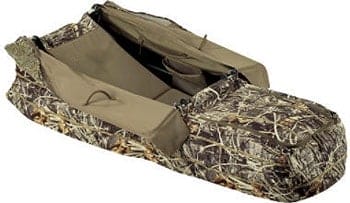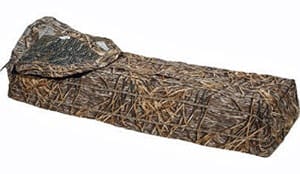
Brett Graham is the owner of Liberty Chesapeakes in the heart of the central flyway. He is proud to offer fellow USA members a 15% discount on guided hunts. Click here for details.
Goose hunting equipment has changed a lot since I began hunting waterfowl 25 years ago. One of the biggest changes has been the advent of the layout blind. They offer a major advantage over the pit blinds many goose hunters relied upon “back in the day,” which is mobility. Layout blinds allow you to move to any field the geese are feeding in, from corn stubble to short winter wheat, while staying concealed. From my experience, the ability to remain concealed is far more important than the type of decoys you use, as most modern decoys are excellent and will help you kill geese.
However, a problem I often see as a guide is that some hunters have a very hard time shooting from a layout blind. I have seen hunters who are excellent shots when standing or even sitting struggle to shoot with consistency from a layout blind. Rising up from their back, albeit from an elevated position, many hunters’ shooting mechanics go out the window when they hear someone yell “take em.”
This is understandable as there is a lot going on. First, you are trying to raise your upper body to an upright position without using your hands, which are reaching for your gun. At the same time, you’re trying to find your gun without looking down in order to keep your eyes on the bird you intend to shoot. And, of course, you’re trying to do all of this very quickly. For the inexperienced, this usually leads to rushed shots and a lot of misses.
The trick to shooting successfully from a layout blind is practice. Whether or not you own your own layout blind, you can work on the techniques needed to be successful. I tell my clients to use the following exercises:
If Using a Full Frame Blind
Stack pillows on your living room floor and lay back on them with your shoulders 16 to 20 inches off the floor. Lay your empty shotgun on a pillow or two, at the same height as the one you are laying on, between your knees. Lay back and practice raising yourself up using only your core muscles while you raise your gun in your hands. At the same time, keep your eyes fixed on a spot on the wall that represents the “bird” you plan to shoot.
 If Using a Blind Without Doors (ex. Avery power hunter)
If Using a Blind Without Doors (ex. Avery power hunter)
Stack pillows on your living room floor and lay back on them with your shoulders 16 to 20 inches off the floor. Lay your empty shotgun on the floor next to you with the barrel lying across your leg and the muzzle several inches beyond your feet. Lay back and practice raising yourself up using only your core muscles while you raise your gun in your hands. At the same time, keep your eyes fixed on a spot on the wall that represents the “bird” you plan to shoot.
Practice these techniques slowly, focusing on your gun mount. It may feel awkward at first, so repeat the process until you feel comfortable. Then you can work on your swing by tracking the barrel at the point where the ceiling and the wall meet, keeping the bead of your gun right in the place where they join, which will help you with any crossing shots. To practice shooting rising or descending birds, use the corner of your living room and swing your gun up and down from this position.
Don’t worry about opening the doors on the full frame blinds as your shoulders will do it for you. As for blinds with a lid, right-handed shooters should use their left hand to open it while reaching for the gun and left-handed shooters should use their right to open it.
If either you or your hunting buddy has a place where you can shoot trap, I recommend that you practice shooting from your blind or at least from a layout position, if you don’t own a blind.
If you are having trouble shooting from layout blinds, I promise these techniques will improve your shooting dramatically. Focus on being smooth when you practice and speed will follow.



